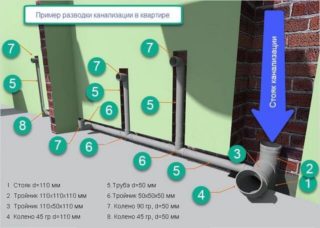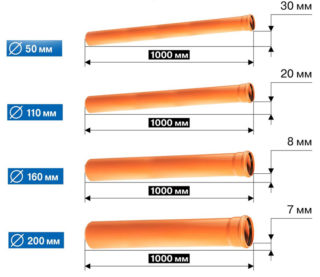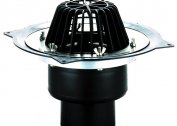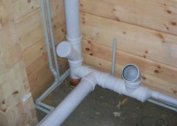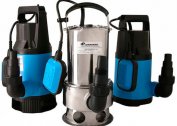In the construction of autonomous sewers - internal and external - pipes with a diameter of 110 mm and 50 mm are most often used. They can be made of any material - plastic, concrete, steel, cast iron, ceramics. Each has its own advantages and disadvantages, so it is important to find out which is most suitable for installing sewage.
Scope of application of a sewer pipe with a diameter of 110 mm
Sewer plastic products with a diameter of 110 mm are made in two colors. Gray pipes - for internal wiring and common riser. Not intended for use at low temperatures. Orange sewer pipes - for the external highway. They have a higher coefficient of strength, withstand frost. A common drawback for all polymer products is the inability to operate at extremely low temperatures, therefore, in the conditions of the northern regions, it is necessary to strictly follow the installation rules and lay pipes below the level of freezing of the soil. As an option - choose another material for the sewage system.
In addition to sewage, a pipe with a diameter of 110 mm can be used:
- for casing a well, but it is necessary to immediately provide for which pump such a pipe is suitable for;
- for organizing irrigation in suburban areas - a product with a diameter of 110 mm can serve as an eyeliner, from which pipes of small section are stretched for a drip system;
- in drainage systems and storm sewers;
- for the protection of electric cables in industrial enterprises;
- for transportation of liquid waste, including chemically aggressive, whose temperature does not exceed 45 degrees;
- for the construction of a water supply system, but only for cold liquid.
The strength of each material must be specified upon purchase, depending on the purpose of use. Perhaps you should not overpay for some characteristics if the pipe section is on the ground surface and can be replaced at any time.
Materials of manufacture
Steel, cast iron, concrete - heavy materials for arranging the sewer system. For its installation, you will need to use construction equipment, which will entail additional costs. In addition, the inner surface is not perfectly smooth, so organic substances remain on the walls and eventually form plugs that will have to be cleaned.
Plastic pipes have a smooth inner surface, do not oxidize. If the pipeline is installed in accordance with all the rules, it will be difficult for organic substances to attach to the walls. As a result, the highway will require less maintenance costs, and sometimes it will not be necessary to clean or repair it at all.
To weigh the pros and cons, you need to evaluate the characteristics of all available materials and choose the right one.
HDPE Polyethylene
Low-pressure polyethylene is a fairly durable material, especially its latest modification PE 100. Suitable for embedding in concrete and laying in the ground, but the joints must be made using a welding machine necessary for working with PE 100, otherwise they may disperse during operation and expensive repairs will be required.
The advantage of polyethylene is that when the water freezes inside, the pipe expands, but does not burst. When thawing, it takes its usual form. In the northern regions of the product, before laying in the ground, they are additionally insulated with lacquered basalt stone wool.
A 110 mm polyethylene pipe can be used in pressure and non-pressure sewers, as well as in pressure water supply systems.
Nvvc
Unplasticized polyvinyl chloride (NPVC) - is used in pressure and non-pressure systems. The service life is about 50 years, which is comparable with the maximum service life of steel structures. Suitable for transporting relatively hot liquids. Withstands temperatures from - 50 to +78 degrees. NPVH is considered an environmentally friendly material, as it does not emit harmful substances into the environment and into drinking water. A pipe with a diameter of 110 mm with a bell-shaped joint system is used for casing artesian wells with a depth of up to 300 m. NPVH does not affect the taste characteristics of water.
Unplasticized polyvinyl chloride is non-combustible and has low thermal conductivity. NPVH pipes for external sewage is one of the most correct decisions in terms of price and quality.
Ceramics
The raw materials for the production of ceramic water and sewer pipes are environmentally friendly - it is clay. Under the influence of high temperatures, the products are strong and durable. They are not expensive to manufacture, so 110 mm ceramic pipes successfully compete with plastic ones.
The material does not respond to sudden changes in temperature, tolerates heat and severe frosts well. So that the water inside does not freeze, it is necessary to additionally insulate the street segment of the highway. The ceramics are not susceptible to corrosion, and pipes with a diameter of 110 mm are coated with glaze from the inside for additional protection against aggressive chemicals and organics.
Polypropylene
Pipes 110 mm made of type 3 polypropylene have increased strength characteristics and are resistant to heat - able to withstand temperatures up to 110 degrees for a short time. Chemically inert to acids and alkalis, therefore, well suited for the arrangement of sewers. The material tolerates lower temperatures worse - at most minus 10 degrees, so polypropylene is insulated for laying in the ground.
Steel
Steel wiring is most often done for urban sewage, as the material has increased strength characteristics and can be used in conditions of vibration and ground movement - under freeways. For home systems, such material is rarely used due to the heavy weight of steel products. To install them you need to use special equipment.
Steel is not resistant to corrosion, in addition, organic waste and mineral deposits remain on the pipe walls and reduce throughput. Corrosion-resistant coatings do not give a full guarantee of quality work, as they wear out over time. Steel pipes 110 mm are gradually replaced by plastic, as they have approximately the same service life.
Polyvinyl chloride
PVC pipes 110 mm are designed for operation in a limited temperature range - from 0 to 45 degrees, which is not always suitable for consumers. They are used mainly for transporting cold tap water. In addition, for the winter period they must be insulated without fail.
PVC pipes are produced in a limited diameter from 110 to 200 mm, so they are suitable for home construction, but larger sizes are required for capital construction.
PVC non-pressure sewer pipes must be laid in the ground in compliance with all the rules for connecting the end parts and the slope of the highway.
Concrete
Reinforced concrete pipes can be laid to a great depth - up to 6 meters. They withstand the pressure in the system, so they are used in pressure sewer highways - private or urban.
The service life of reinforced concrete is more than 80 years with proper operation and timely maintenance. Concrete is resistant to corrosion, but unsafe from the point of view of bacterial infection, so this material is not suitable for supplying drinking water to the house.
Cast iron
If earlier it was believed that cast iron was a bad solution for private sewage due to a rough inner surface, now there are metal grades that can compete with plastic in the smoothness of their inner walls. At the same time, cast iron is a very heavy material, so it is rarely used in home construction, especially with a limited budget.
Coating with anticorrosive mastics prolongs the service life of products and makes it an almost eternal material that does not require replacement and maintenance.
Dimensions
Red sewer pipes with a diameter of 110 mm can have different wall thicknesses - from 5 to 150 mm. It depends on the internal diameter and installation location - in the pressure or pressure line. In systems where fluid is transported under pressure, the walls must be thicker to withstand constant loads and not be deformed.
The length of the pipe segment for each material is determined by GOST standards. Some plastic products can be transported in bays - for the convenience of customers. The desired length is measured and twisted, then fixed.
Criterias of choice
In order to choose the right material for the arrangement of sewage, the following parameters must be considered:
- temperature regime of the region - the stronger the frosts, the more stable the material should be;
- the depth of laying in the ground and the degree of mobility of the soil, as well as the presence of vibrations;
- pressure or pressureless sewage - for pressure, material with thicker walls is required;
- internal or external system;
- Do you need sound insulation - cast iron well reduces sound waves, plastic does not remove them.
One of the selection criteria is price, but saving on installation or connecting elements is not recommended. Defective parts can shorten the life of the unit or lead to repair costs.
Mounting Features
Plastic pipes are mounted by several methods - welding using special equipment, fittings. When welding, most polymers form strong joints that do not diverge over time. Press fittings are more reliable in mounting joints and are recommended for closed use - in concrete, in the wall, in the floor. Crimp fittings are made when there is access to the seam and can be repaired at any time.
Steel pipes are connected only by welding, especially with a large depth of laying in the ground.
Cast iron and ceramic pipes have a special device for connection - a bell. For sealing, various mastics are used so that liquid does not leak through the joint.
Pressure sewage can be mounted horizontally, as drains will be transported using a pressure boosting pump. For pressureless sewage, a slope must be observed. For a 110 mm pipe, it is 2 cm per linear meter. This is necessary so that the trunk does not silt and the throughput does not decrease.
The cost of pipes depends primarily on the amount of consumables, and its composition. For the production of plastic, the cheapest raw materials are used, so the final price for plastic sewer pipes with a diameter of 110 mm will be lower than for steel or cast iron products. In this case, the wall thickness and the length of the segment are important. New material modifications can cost more, but before you pay, you need to find out how useful the characteristics will be.
